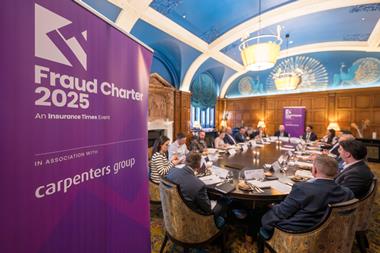The SME sector was once lucrative for insurers, but new entrants to the market increasing capacity, coupled with cash-strapped clients looking to shave costs, have put downward pressure on rates and revenues. We look at how the industry can keep its head above water
Few sectors of the economy have been as hard hit by the recession as small and medium-sized enterprises (SMEs). Although insolvencies in the sector appear to have stabilised in the last nine months, a large number of SMEs have gone to the wall during the past two years.
Meanwhile, those that have survived have been forced to endure sharp falls in turnover, continuing economic uncertainty, and have lost all access to capital. Banks – the sector whose excesses caused the recession – pulled the plug on lending soon after they themselves had squirrelled away the billions of pounds lent to them by the government.
Bearing in mind the ubiquitous role of SMEs in the economy – they account for more than 95% of the UK’s 4.9 million businesses – their current woes have had a significant impact on the insurance industry.
The SME insurance market, one of the industry’s largest sectors, is worth around £6bn in gross written premium. Traditionally, it has been an extremely profitable market for insurers. But in recent years, premiums have suffered on the back of a double whammy of increased competition – which has seen insurers charging less and less for cover in order to retain a healthy client base – and the impact of the economic crisis. This has left SME clients unable to afford as much cover as they were buying in the pre-recession times.
Treading water
Constantly seeking better deals for products within their supply chain, including insurance, is of course paramount for small businesses at all times. But during an economic downturn, the need to keep a tighter rein on costs intensifies, and insurance cover is one of the first things small businesses look to cut back on when seeking to reduce operating costs. The impact on insurers is that clients now demand the same amount of insurance cover for less money or, failing that, less cover.
“Most businesses, but particularly SMEs, are looking to cut costs,” QBE managing director of commercial business insurance Graeme Rayner says. “That means rates in SME are broadly flat and it’s difficult to see that changing at the moment. It’s a tough market.”
Indeed, anecdotal evidence suggests that insurers often have to offer premium discounts of between 5% and 10% to retain business in the current market.
“Rates have been under pressure for quite a while – commercial property in particular is soft – but over the course of the downturn there has been less take-up of packages, with many firms sticking to compulsory elements,” PricewaterhouseCoopers non-life actuarial senior partner Paul Delbridge says. “People are still nervous about the strength of the recovery: they are not hiring at the moment and are only looking at capital spending on a gradual basis. Against this backdrop, we don’t see a rapid return to SMEs requiring as much insurance as they used to.”
Delbridge’s pessimism about the future is borne out by a report released by Aviva earlier this year, which revealed that just 14% of small business owners were optimistic about economic prospects for the year ahead. The upshot of all this is that insurers will have to live with companies looking to scale back their cover, or get a hefty reduction on the same policy, for some time to come. But things could be worse: the report also showed a marked increase in the number of businesses that were not taking out any commercial insurance over the last year.
Mixed feelings
However, not everyone in the industry is as pessimistic about the current or future state of the sector.
Jelf’s insurance chief executive, Phil Barton, believes there are distinct signs of improvement amid the gloom. “Yes, the recession has had a profound impact on the SME market, and pretty much every business was looking to reduce its cover after it hit. But we saw some premium inflation in the market in the first half of this year, and I think the sector is improving.
“Rates were probably going up last year but exposures were reducing faster, so the net impact on premium was downward. Now exposures have stabilised and if anything are moving forward slightly. Rating is coming through as well, so things are looking healthier.”
But despite that bullish assessment of the sector, Barton remains in a minority. While Groupama commercial lines director Malcolm Smith agrees that rates showed signs of improvement last year, he believes the continuing impact of the recession has wiped out those gains this year. “Last year we had a 1% rate increase in SME business generally. It wasn’t much of course, but it was a move in the right direction. This year it has changed to a small negative. Some classes, such as pubs and hotels, have gone up, but across the whole sector, price rises are just not happening now,” he says.
But the impact of the recession is only part of the problem in SME insurance. There are around a dozen insurers competing for SME business, which is too many for some of those operating in the sector. SME is dominated by the usual suspects, with Aviva, AXA, Allianz, RSA and Zurich accounting for around 60% of the market. Beneath that top tier, there exists a raft of smaller insurers and new entrants to the market, which are fiercely competing for the shrinking premiums on offer.
Aviva is the largest player in the sector with an estimated 14% of the market. Commercial product manager David Bruce says: “I think there will be downward pressure on rates for a while. Everybody is keen to build up their portfolio and pick up business in this sector, so rates are soft.”
This battle for SME premium has led to some insurers accusing many of the new entrants to the sector of aggressively ‘buying premium’ in a bid to build up their book.
“Some insurers are driving prices down to seize market share in SME,” PwC’s Delbridge says.
“Five years ago, the SME space was really quite profitable. But since then a lot of people have rushed into that market space and now there is too much capacity.”
Delbridge’s assessment of the market is echoed by Groupama’s Smith. “There is excess capacity. The prices we’re writing business at now means there is no margin for catastrophes or any significant bad news that could hit the market. The biggest driver of rates has been the drive by smaller to medium-sized insurers seeking to grow their SME book quite aggressively. That makes it difficult to increase prices.”
Testing the water
One of those aggressive smaller players is LV=, which is rapidly expanding its SME book, writing 50% more business this year than it did in 2009. But LV= commercial director Mike Crane is unrepentant about the company’s business model and is happy to be ruffling the feathers of the established players.
“To say we’re buying market share undervalues the approach we are taking in this sector,” Crane insists. “One of the benefits of a new entrant to a sector like this is that we come in with a fresh approach, fresh systems and fresh products that customers want to buy.
“It’s about making sure there are efficiencies in your model to ensure you can make money. We’ve entered the market because we see there is a profit to be made, but you have to get the service proposition right to do that. Some of the larger players have more of a challenge in terms of changing their legacy systems to fully embrace modern ways of trading.”
Another new entrant to the sector is US group Allied World. Its European vice-president for SME and professional lines Kevin Cleary insists that talk of new entrants buying market share is simplistic.
“SME has been a tough market since 2004. Some insurers want to get premium on their books as quickly as possible, whereas others, including ourselves, want to do things slowly and surely, and build a profitable book in an area that we know is historically profitable. It’s not about getting volume delivery and premium through the door. It’s about positioning yourself correctly for where you want to be in the next five years.”
Cleary says it is unhelpful to all parties in a transaction to chase prices down. “The market is getting to a stage now where insurers are finding it difficult to make money out of risk in certain sectors. But the bottom line for us as a new entrant is that we can take advantage of any churn in the market by delivering on service, product, price and overall flexibility. There’s always going to be pressure on prices when new entrants come in. But the SME business is historically profitable and will be in the future. It’s sought-after business,” he says.
Traditionally, the amount of churn in this sector has been negligible. SMEs buy insurance almost entirely through brokers and have a much stronger loyalty to both brokers and insurers than other sectors of the industry.
“All this idea of large multinationals muscling into the SME market frankly isn’t happening and I doubt it ever will,” says Jelf’s Barton. “You need to know and understand the local communities you’re operating in to be effective in the SME space. Some of the new entrants have tried to play in that market and have had some success. But clients tend to like long-term relationships. They want to drive a hard bargain, but prefer to keep their cover with the holding insurer and holding broker.”
Hoping for buoyancy
So what hope is there in the future for rates to rise to a more profitable level in SME insurance?
“If a significant natural catastrophe occurs, it could push rates up,” PwC’s Delbridge says. “The advent of Solvency II could also have an impact, in that it will make insurers increasingly look more and more at their return on capital. Some may ask, ‘why are we diverting capital to an area that is producing low returns?’ That could cause some insurers to withdraw from SME, or certain tranches of the sector. This, in turn, could push prices up as capacity shrinks.”
Shrunken capacity in the personal motor market undoubtedly helped increase rates in the sector over the past year. But the main factor behind the bullish rises in personal motor was the insurers’ determination to collectively raise rates and hold them.
“Ultimately, only insurers’ results will drive the market,” Smith says. “At the moment, commercial lines results have been held up by significant prior-year releases, but those releases are obviously drying up. It will take some poor results before insurers react, and at the moment they are not poor enough.”
Aviva’s Bruce agrees. “I certainly don’t see anyone exiting the sector. It is still a good sizeable market, and it’s normally a quality business that provides good levels of return. Everyone wants to be in it, it’s just a question of making sure the underwriting price is right.” IT





































